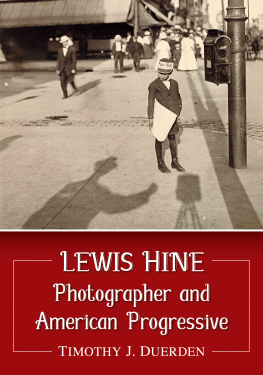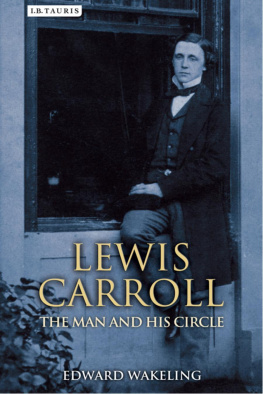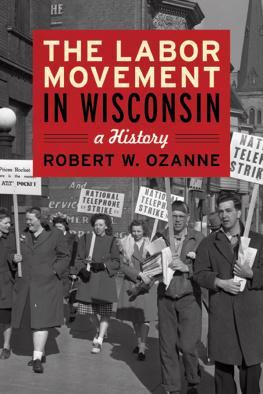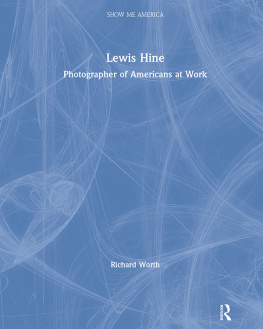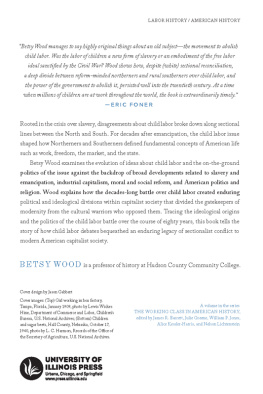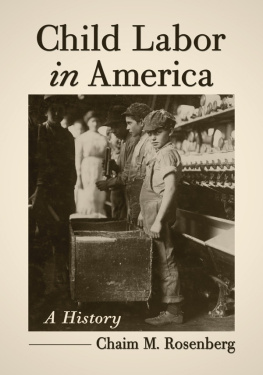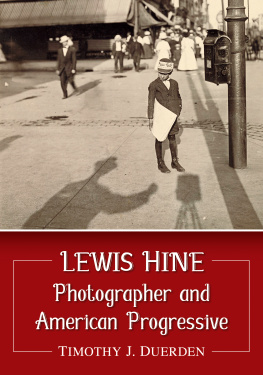
LEWIS HINE
Photographer and American Progressive
Timothy J. Duerden

McFarland & Company, Inc., Publishers
Jefferson, North Carolina
LIBRARY OF CONGRESS CATALOGUING DATA ARE AVAILABLE
BRITISH LIBRARY CATALOGUING DATA ARE AVAILABLE
e-ISBN: 978-1-4766-3262-9
2018 Timothy J. Duerden. All rights reserved
No part of this book may be reproduced or transmitted in any form or by any means, electronic or mechanical, including photocopying or recording, or by any information storage and retrieval system, without permission in writing from the publisher.
Front cover: The shadow of Lewis Hine and his camera are visible in this photograph of an Indianapolis newsboy. Hines caption for this image reads: John Howell, an Indianapolis newsboy, makes $.75 some days. Begins at 6am Sundays (Lives at 215 Michigan Street). August, 1908. Library of Congress, Prints & Photographs Division, National Child Labor Committee Collection [reproduction number, LCDIG-nclc-03225].
McFarland & Company, Inc., Publishers
Box 611, Jefferson, North Carolina 28640
www.mcfarlandpub.com
To my parents,
William and Sheila Duerden
Acknowledgments
I would like to express my gratitude to Dr. Elizabeth Bloom, Hartwick College, Oneonta, New York, and to Dr. Kirby Olson, State University of New York at Delhi, both of whom took time to read early versions of my manuscript and to offer useful feedback in the form of criticism, suggestions and encouragement.
For providing information on the early life of Hine in Wisconsin, I thank Dr. Susan Nuernburg, University of Wisconsin at Oshkosh. Gratitude is also extended to Connie Carmical of Oshkosh Community Media Services.
I am grateful to Harriet Rich Law and her daughter Sally Hebbard of Franklin, New York, for their willingness to share family lore and insights into the personal lives of Hine and his wife, Sara Ann Rich, here in the Catskill Mountains. In the same vein, I express my appreciation of Robert Breiling, who spoke to me of his recollections of the Hine family and their life in Hastings-on-Hudson during the 1930s.
I extend my thanks to Rachel Stuhlman (now emeritus), librarian and curator of rare books at the George Eastman House, Rochester New York; Lauren Lean, digital asset coordinator at the George Eastman House; Greene County Historical Society in Coxsackie, New York; and the archivists at Smith College, Northampton, Massachusetts.
To my family for bearing with me during all this time of research and writingthank you.
Preface
There is urgent need for intelligent interpretation of the worlds workers, not only for the people of today, but for future ages.Lewis Hine
The name Lewis Wickes Hine meant very little to me until the late 1990s when I relocated from Philadelphia to Franklin, a tiny Delaware County village located in upstate New York and a place I now consider home. Soon after moving here I learned that the mortal remains of Hine and his wife, Sara Ann, are buried in the village cemetery. As the months and then the years of the new millennium passed, I would occasionally stumble across a reference to Hine in a local history book or read an article in some other publication. And in late 2007, just as I was wrapping up the writing portion of my local history book, I was again reminded of his final resting place while doing research on a village walking-tour brochure I helped produce. In this rather haphazard manner I came to finally recognize the name. But why, I asked myself, should the fact that Hine lay buried in my hometown be a claim to fame for the local community? Just who was Lewis Wickes Hine anyway?
I had intended in short order to pursue these vague musings on Hine, but then, as happens, my attentions were pulled elsewhere and my initial curiosity about the man faded. It wasnt until several months after the publication of my own aforementioned book, as I was looking around for another worthy and interesting topic to research, that I recalled Hine and his connection to Franklin. Once more my curiosity was arousedonly this time I believed I had the time to do something about it. Thus, during the quiet winter months of January and February 2009really more on a whim than anything elseI decided to search out additional books and articles in order to learn more about Hine and his life. It didnt take much reading to find that today, among those who know about these things, he is considered one of Americas greatest and most influential 20th-century photographers and social reformers. Moreover, a cursory search of the Web brought up a great many images of Hines with which I was already quite familiarand a great many more with which I was not.
Several weeks passed, during which time I sifted through hundreds and perhaps thousands of photographs online and even viewed a small exhibit on Hine produced by students at the local high school in Franklin. It was soon after visiting the exhibit that it began to dawn on me that Hines personal story needed to be told in broader strokes. And as an inhabitant of the village where he spent considerable time (and where he remains to this day), I convinced myself that I was the one to tell that story. This biography is the result of those initial weeks of discovery about Lewis Hine and my own very real personal realizations that took place back in early 2009.
First, however, back to the graveyard. If was going to write about Hine, I thought it incumbent upon me to lay eyes on his gravestone. Therefore, after a lengthy wait for the snows to melt, late one Saturday afternoon in early spring at a time when the ornate wrought-iron gates of the cemetery were still firmly chained and padlocked, I hopped over the low stone wall that separates the main road from the burial ground and began the hunt for his memorial. As I traipsed around the hilly cemetery, slowly making my way in and out of the multitude of headstones, I wondered again what in Gods name the mortal remains of such an illustrious person were doing here in the remote western Catskill Mountains. After all, neither Lewis nor Sara Ann Hine was a native of Franklin, or even of New York State. There was no one fool enough but me in the cemetery that cold spring day and I might not have succeeded in finding the graves location on my own if a neighbor hadnt previously given me a rough idea of where to look. As it was, it must have taken half an hour or longer, by which time wisps of snow had begun to fall from crepuscular, leaden skies, before I stumbled upon the shared headstone of Lewis and Sara Ann Hine.
Theirs is just one of many hundreds of modest markers that dot the rolling landscape, and it protruded only a few inches above the earth and was tucked away at the very back of the graveyard. Indeed, almost immediately beyond their resting spot the terrain begins to slope and then falls precipitously away to the woods and stream below. Lewis name is etched simply in the stone face on the left side of the small triangular bluestone tablet and Saras on the right. Not only, then, is Lewis Hines final resting spot in a remote and what can be considered an unlikely little village cemetery but even within that little cemetery, if one is truly intent on finding his memorial stone, one really has to go hunting for it. Why was Hine not buried in a more prominent location? Why not a more elaborate memorial? Naturally, these questions caused me to grow still more curious about what had happened to this once well-known man.
Next page
